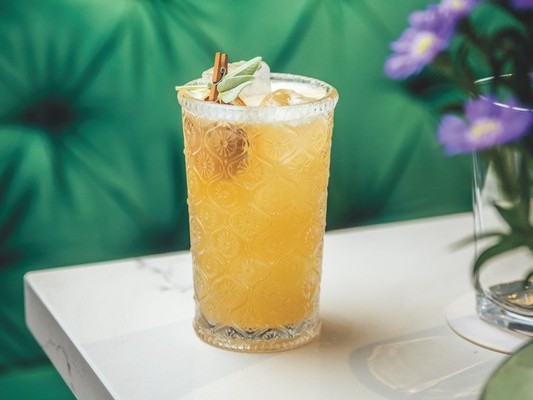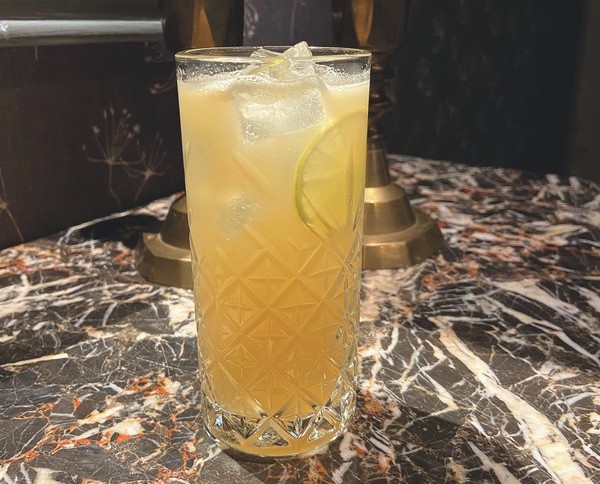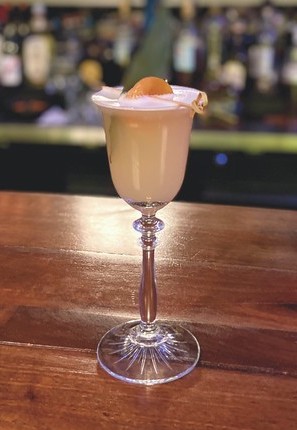
In recent years it’s become more widely accepted that Scotch can be more than a sipping spirit. “Many guests still want to drink their Scotch on its own, but there’s been a shift toward using more Scotch in American cocktails,” says Darron Foy, bar manager of The Flatiron Room in New York City. “I recently made a couple of Rob Roys with peated Sherry-finished single malt Scotch—I could not have imagined making that a few years back.”
Single malt Scotch, in particular, has historically been seen as too pricey to mix into cocktails, but bartenders are helping to change that notion. “They’ve become a bit more relaxed about opting for a single malt for their Scotch cocktails,” says Alex Barbatsis, head bartender at The Whistler in Chicago. “Also, lots of new blended Scotch has been added to the market, including some nice peated ones that are cost-friendly and pack a punch in a drink.”
Even single malt Scotch producers have started encouraging bartenders and consumers to shake things up with Scotch. “We’re seeing certain brands marketing their Scotch for cocktails, or at least showcasing the versatility of their spirit,” Foy says. “Glenmorangie X springs to mind as an example of a Scotch made for mixing.”
Nicholas Bennett, beverage director at Porchlight in New York City, also notes that there’s more high-quality mixing Scotch on the market today, which he attributes to the cocktail boom. “The popularity of the Penicillin is a great example of how Scotch can be more than just an accent in a cocktail and brands responded to that by releasing finely crafted bottles for the well,” he says. “I want to see more movement away from the ‘you can only drink Scotch with one ice cube’ crowd. There are so many kinds of Scotch available, so there has to be more than one way to enjoy it.”

Challenge Accepted
With Scotch’s long history of enjoyment as a standalone spirit, it can pose a challenge for mixologists, but that’s also what makes it exciting to work with. “A majority of Scotches tend to be so intense in their flavor composition that balancing them out in a cocktail can prove difficult. Mixologists have to find that very fine line where the unique attributes of Scotch are neither overpowering nor drowned out—it’s a much smaller sweet spot than balancing cocktails with other styles of whisk(e)y,” notes Nick du Mortier, head mixologist of Chateau Carbide and Bar Pendry at the Pendry hotel in Chicago. “Scotch has a particularly purist contingent of fans to contend with, so a well-balanced Scotch cocktail can be a pleasant surprise to adventurous patrons who would have never considered ordering a Scotch cocktail before.”
At Bar Pendry, du Mortier’s Carnegie Lemon ($28) features Oban 14-year-old single malt Scotch, house-made chamomile honey syrup, lemon juice, and club soda. “As we’re seeing Scotch’s popularity rise and more people growing accustomed to its unique notes, it could very well move to the spotlight of more casual Highball cocktails and onto the main stage at craft cocktail bars,” he adds. Bullard Tavern in Portland, Oregon, offers the Mamie Taylor, which is an oft-forgotten pre-Prohibition Highball of Scotch, lime juice, and ginger beer. The bar’s version ($12) blends The Famous Grouse Smoky Black blended Scotch, fresh lime juice, house- made ginger syrup, and soda water. “It’s simple and refreshing, but the Scotch adds a nuance to the drink that wouldn’t usually be there,” says Bullard Tavern bartender Valerie Carrasco. “Scotch not only fortifies a drink, but it also brings a level of complexity and depth to it.”
Scotch and ginger make a very popular pairing, especially since the creation of the Penicillin cocktail in 2005 by bartender Sam Ross at Milk & Honey in New York City. At Bar Pendry, du Mortier’s Simple Remedy ($22) is a refreshingly light nod to the Penicillin that comprises Dalmore 12-year-old single malt Scotch, Domaine de Canton ginger liqueur, and lemon juice. Similarly, a lighter take on the Penicillin, the Tocayo ($19) at Leku in Miami by beverage manager Daniel Love mixes Glenmoran- gie Lasanta 12-year-old single malt Scotch, Ardbeg Wee Beastie Scotch, house-made lavender honey syrup, lemon juice, muddled ginger root, and East Imperial Mombasa ginger beer.

“Scotch is easily one of my favorite spirits to work with; I’ve learned to appreciate the subtle caramel and choc- olate notes that come out during the aging process, and to pair this with amazing spices like ginger and clove to bring them out,” says Adam Mason, general manager of Louvino Highlands in Louisville, Kentucky. His Ginger Snap ($15) features The Balvenie DoubleWood 12-year-old single malt Scotch, lemon juice, house-made ginger-clove simple syrup, and Fee Brothers Aztec Chocolate bitters and Orange bitters.
“Historically, a less expensive blend would be more common in calls like a Rusty Nail, a Rob Roy, or a Bobby Burns, but as bartenders and consumers become more interested in Scotch, along with a shifting landscape of styles within the category, there are far more opportunities to utilize single malts in some of those classics,” says Tommy Klus, owner of Scotch Lodge in Portland, Oregon. His Namesake ($16) comprises Bowmore 12-year-old single malt Scotch, Cynar amaro, Punt e Mes vermouth, Combier Roi René Rouge Cherry liqueur, and Regans’ No. 6 Orange bitters. “Our Namesake cocktail continues to be a crowd favorite and has remained on our menu since day one,” Klus adds. “It drinks somewhere between a Rob Roy and a Negroni with layers of bittersweet smoke, dark cherry, hints of chocolate, and touch of orange oil.”
The Whistler’s Barbatsis notes that Scotch drinkers can be a bit protective over Scotch cocktails, and rightfully so. “They don’t want to lose the qualities of a Scotch that producers worked so hard to create, so when I’m creating a cocktail that incorporates it, I want to stay true to the spirit’s original essence while working to enhance the flavors that are already there,” he explains. His Miel Ticket ($13) mixes Bank Note 5-year-old blended Scotch, Carpano Classico sweet vermouth, Bénédictine herbal liqueur, and Dr. Adam Elmegirab’s Dandelion & Burdock bitters. “I developed this cocktail to drink like a Scotch on the rocks,” Barbatsis adds. “The vermouth adds a little extra round- ness to the blended Scotch, and the bitters add great pine, cardamom, and wood notes often found in longer-aged Scotch.”

Find Your Style
Bar Pendry’s du Mortier notes that while many consumers who aren’t very familiar with Scotch expect it to be “nothing but smoke,” the spirit actually varies in flavor depending on the style and region of origin. “Considering which region you’re pulling from is a great first step in making sure your cocktail highlights the Scotch’s unique flavors,” he advises. “For example, an Islay scotch is going to add a peaty, smoky note to your cocktail, whereas those from the Highlands tend to impart more delicate notes like cinnamon, citrus, and even florals.”
Indeed, there are many different flavor profiles to be found within the category of Scotch. “Five regions creating differ- ent whiskies to put their stamp on the map means thousands of Scotch flavors to choose from and use in a cocktail,” The Flatiron Room’s Foy says. “I mean nothing against other whiskies or an unaged spirit like vodka as a mixer, but when you’re using Scotch, so much detail has to go into making your cocktail. Is it peated? Is it finished in red or white wine barrels? Or in Port, Sauternes, or Sherry barrels? Maybe it’s Cognac-finished and peated! More flavor possibilities mean more cocktail possibilities.”
Foy adds that he tends to choose a Scotch for a cocktail based on the seasons. He notes that a barley-driven Speyside or Lowland Scotch with light spice and fruit works well in crisp cocktails for the spring and summer, while fall flavors like apple and baking spices pair well with Highland styles that showcase more orchard fruit and nut flavors. “And give me a Laphroaig Rob Roy or Old Fashioned in the colder months for a nice kick to the throat!” he says. “I personally love Islay—the big and bold peat notes with sea spray, iodine, seaweed, wet beech wood, and lashings of salt and smoke. To work with something so robust and try to temper it with other flavors can be intimidating, but when you find that balance, it’s extremely satisfying. I’m a huge fan of Ardbeg—salt-driven, bold, and unforgiving.”

The Smoking Old Fashioned ($20) at The Flatiron Room is infused with smoke from hickory wood chips, and made with Ardbeg Wee Beastie 5-year-old single malt Scotch, Demerara sugar, Angostura bitters, and a dash of soda water. Furthermore, the venue’s Apriscot ($22) also features Ardbeg Wee Beastie, plus Rothman & Winter Orchard Apricot liqueur, lemon juice, simple syrup, and Fee Brothers Orgeat syrup.
Scotch Lodge’s Klus is also a big fan of peated Scotch. “Those with salinity or a noticeable maritime influence can sometimes work much like adding a pinch of salt to a dish where it makes other aspects of the ingredients pop,” he says. “I have yet to find any ingredients or flavors that don’t work well with Scotch, but some of the ones we’ve really latched onto are tropical ingredients such as coconut or pineapple.” At Scotch Lodge, bartender Jessica Braasch’s Islay Daiquiri ($15) mixes Ardbeg Wee Beastie, Plantation Stiggins’ Fancy Pineapple rum, fresh lime juice, house-made coconut-oolong Demerara syrup, and Bittermens ‘Elemakule Tiki bitters. “Some still scoff at the idea of mixing with an expensive single malt or see it as a waste of a good Scotch, but I still have so much fun with the discovery,” Klus adds.
Thanks to this love of discovery among mixologists, Scotch cocktails today are more creative than ever. At Angel’s Share in New York City, head bartender Tsunetaka Imada’s Blue Bells ($19) blends lapsang tea-infused Dalmore 12-year-old single malt, Bowmore 12-year-old single malt, house-made blueberry syrup, The Japanese Bitters’ umami bitters, and Peychaud’s bitters. “Blue Bells is inspired by the deer of Scotland and is a twist on a classic Old Fashioned,” Imada says. “Smokiness and saltiness are brought forth by the Scotch, while the lapsang tea enhances the wood notes. Fresh blueberries remind one of the sweetness deer absorb, and the bitters bring savory aromas.
Porchlight’s Bennett notes that with the wide availability of so many different styles and brands of Scotch on the market today, his guests are more open to trying just about any type of Scotch cocktail. His Damn Fine Rusty Nail ($16) features Monkey Shoulder blended malt Scotch, Drambuie Scotch whisky liqueur, Becherovka herbal liqueur, Angostura bitters, and Bittermens Hopped Grapefruit bitters. “I love a simple blended Scotch for mixing cocktails, and when considering factors like taste, price, and availability, I find Monkey Shoul- der, which is a blend of three Speyside single malts, to be the best,” he says. “Because we’ve seen a growth in quality well Scotch, we’re getting to see bartenders stretch their creative chops. Not just the simple stirred or on-the-rocks cocktail— Scotches are being mixed with everything from passion fruit and coconut to Sherry and barley tea.” His Barley Boys ($16) comprises Monkey Shoulder, honey, roasted barley tea, and Bittermens Xocolatl Mole bitters.
The Whistler’s Barbatsis also favors blended Scotch in cocktails like his Scotch Plains ($13), which mixes The Famous Grouse blended Scotch, Lucano amaro, fresh lemon juice, and Demerara simple syrup. At Gadabout in Chicago, lead bartender Lee Hawkridge’s Unicorn and Eagle ($12) blends Monkey Shoulder, Rittenhouse Rye, Journeyman Old Country Goodness apple cider liqueur, lemon juice, honey syrup, house-made ginger syrup, and celon smoky black tea the bar gets from a local Middle Eastern market. “To bridge the gap between Scotland and the United States, I use a split base of blended Scotch and rye, the classic American spirit, and then I took inspiration from the classic Hot Toddy build, but with a twist,” Hawkridge says, adding that he loves that Scotch is as varied and terroir-driven as wine. “From the smoky peatiness of the Islays to the heathery floral notes of the Highlands, from the sweetness of the Speysides to the salty sea air of Campbelltown, it’s almost ridiculous to classify Scotch as one category. It’s such a fascinating spirit.”


